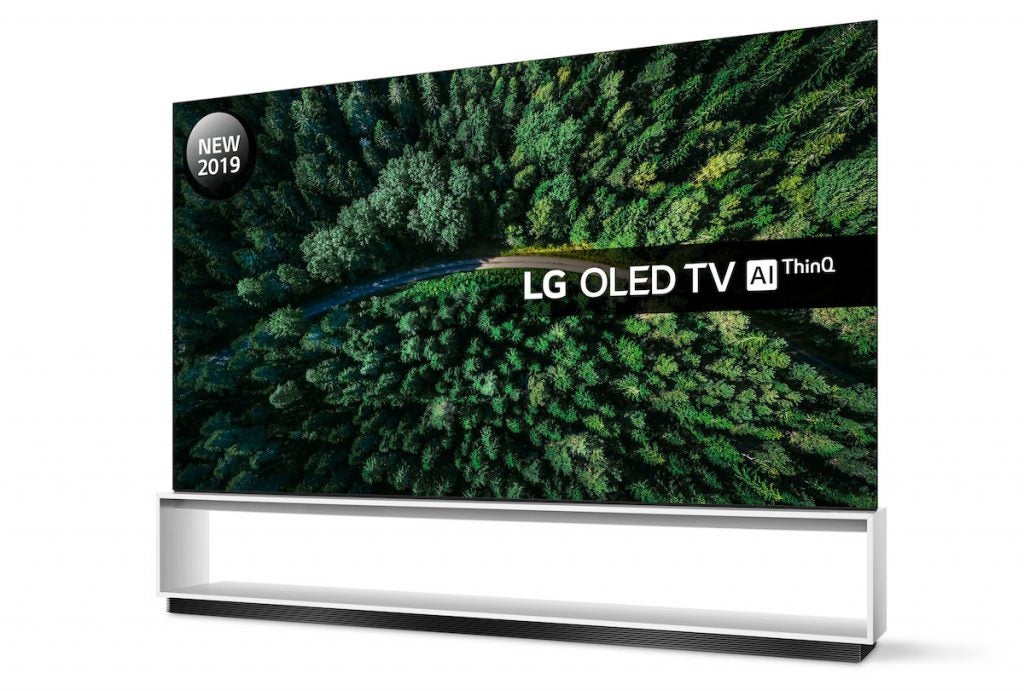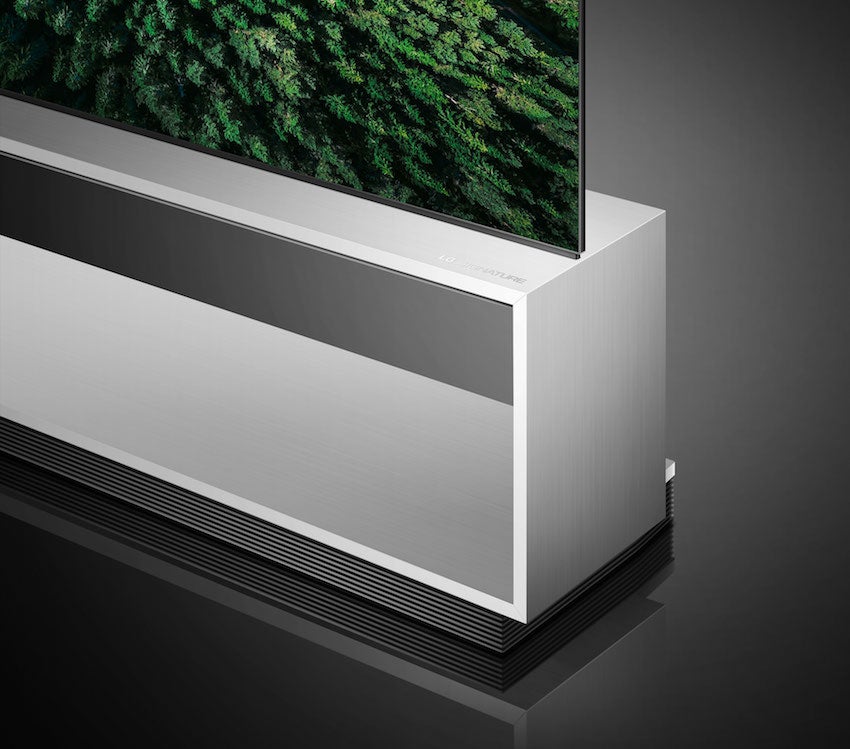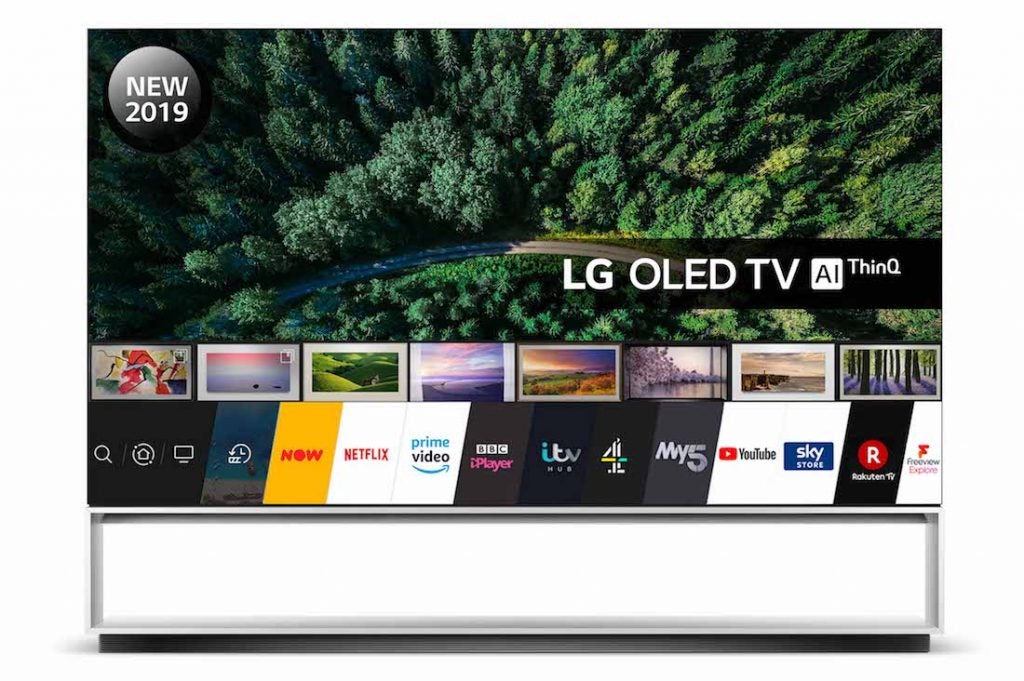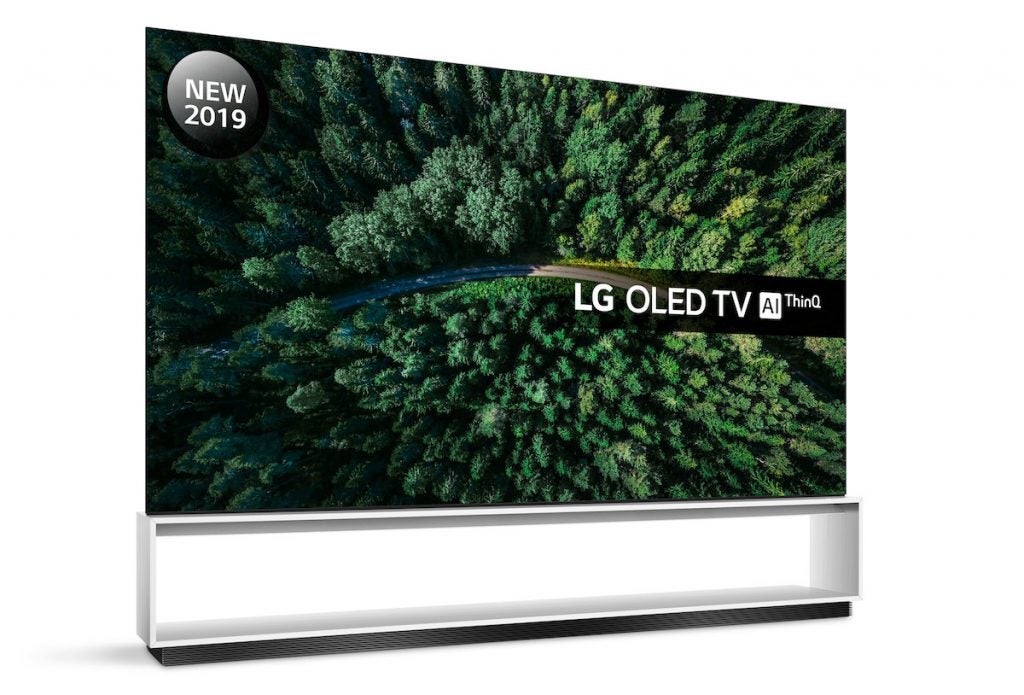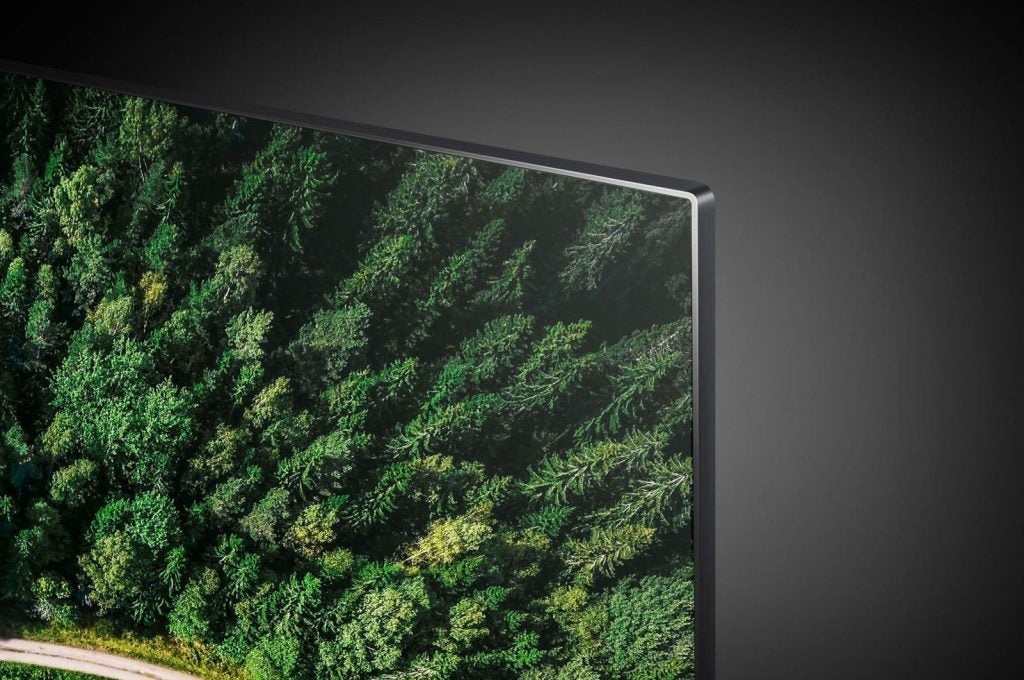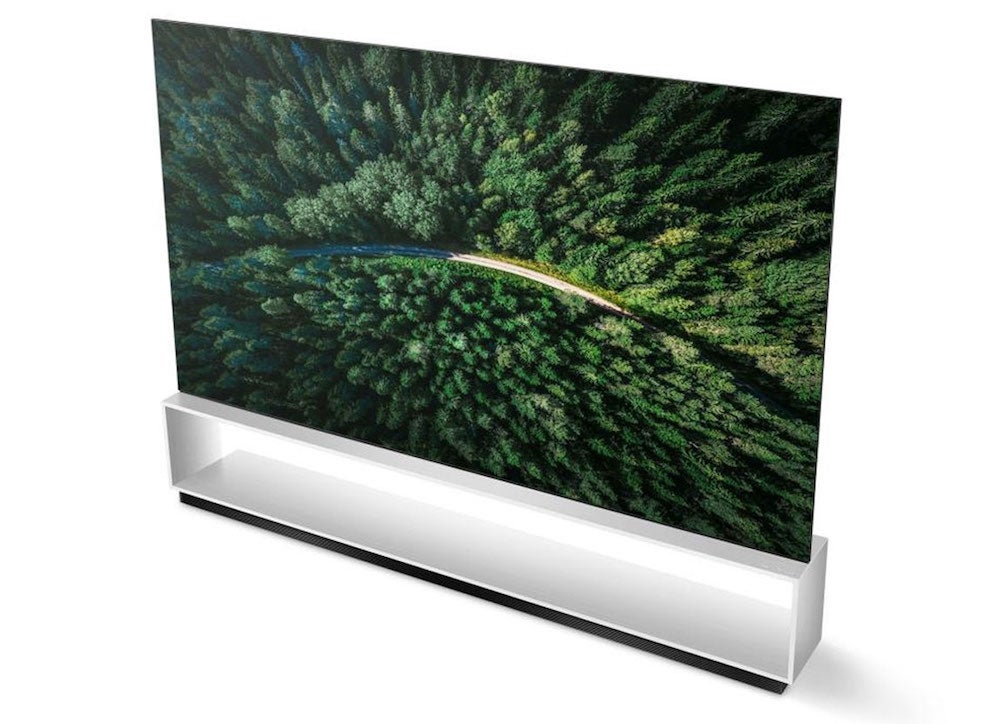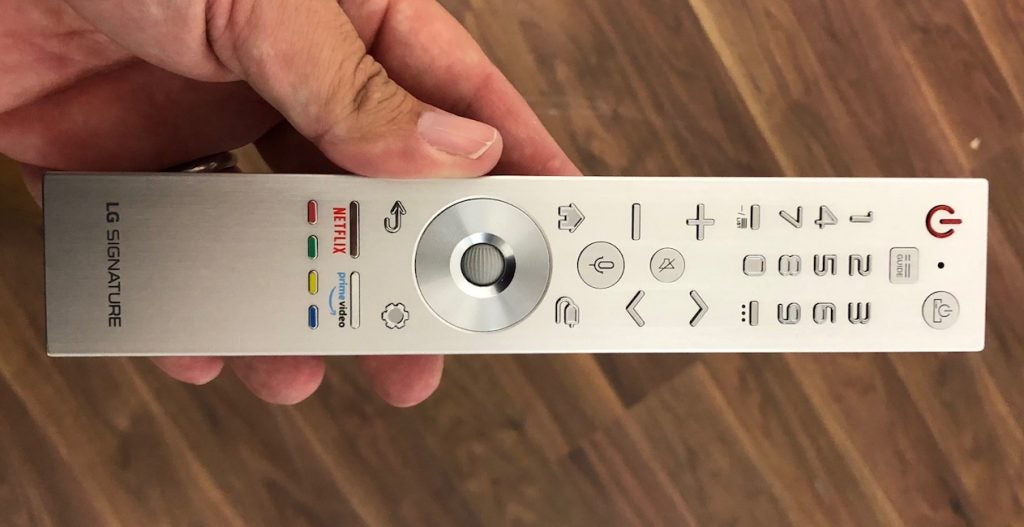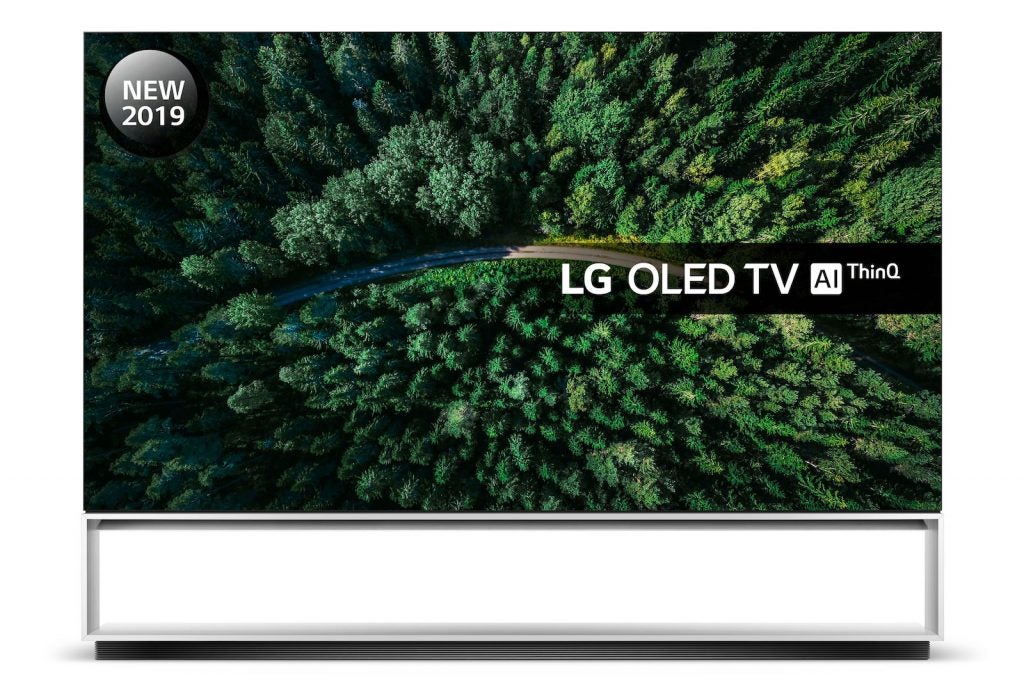LG OLED88Z9 Review
LG OLED88Z9 Review
The world's first 8K OLED TV is sensationally good – but also scarily expensive
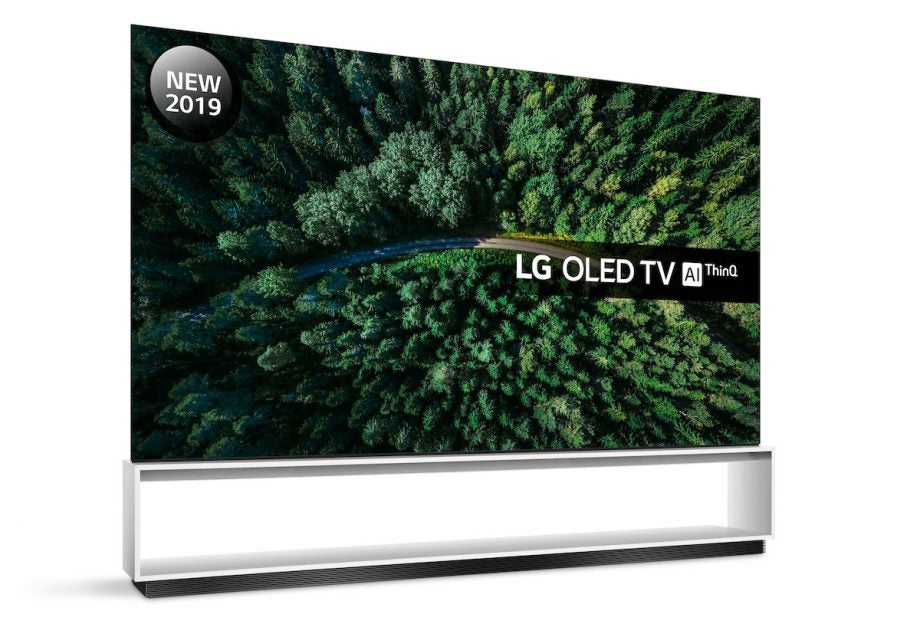
Verdict
The LG OLED88Z9 produces the best all-round picture quality we've seen – at least with native 8K and good-quality 4K sources. However, all that quality doesn't come cheap.
Pros
- Stunning picture quality with 8K and good 4K sources
- Gorgeous design
- Strong smart TV system
Cons
- It isn't cheap
- Needs an external decoder box for non-HDMI 8K sources
- Some streamed sources can look noisy
Key Specifications
- Review Price: £30000
- OLED TV with a native 8K resolution
- webOS Smart system
- Dolby Vision and Dolby Atmos
- Alpha 9 Gen 2 8K processor
- Four HDMI 2.1 ports
What is the LG OLED88Z9?
The LG OLED88Z9 is the first 8K OLED TV. It boasts a spectacular, physics-defying design and squeezes its mammoth pixel count into an 88in screen without compromising on the performance that’s made LG’s 4K OLED TVs such a hit this year.
But is this enough to justify its £30,000 price?
LG OLED88Z9 design and build quality – The largest and most glamorous 8K TV we’ve seen yet
It’s a testament to the glory of the OLED88Z9’s design that the first thing you notice about it isn’t its gargantuan screen size. Instead, you’ll find yourself marvelling at how the screen stands magically upright, despite appearing as if it’s being held in shallow groove on top of a cool bit of silver floor-standing furniture.
It looks just as physically impossible as LG’s wafer-thin “wallpaper” OLED TVs – and about as glamorous an imposition on your living room as any 88in TV is ever likely to be.
The floor stand provides enough space within its open frame design to potentially house most, if not all, of your external sources. However, doing so would obviously detract from the TV’s otherwise beautifully clean, futuristic lines.
The only bum note in the design is the surprising need to add an external 8K decoder box. Without this the LG OLED88Z9 can’t actually play 8K properly – video or stills – via USB or streaming sources.
The decoder box boasts a brushed metal top plate. However, its presence undoubtedly detracts from the clutter-free lines of the main TV, especially since it has to connect to the TV via two cables: one USB, and one HDMI.
The words “LG Signature” are engraved on the floor stand’s top edge, in front of the screen’s bottom-right corner. This – along with its price! – serves as a reminder of the LG OLED88Z9’s premium nature.
Even the remote control is a cut above. It’s finished in a gorgeous brushed metallic silver, feels weighty but well balanced, and sports stand-out metal buttons in a spacious, ergonomic layout.
LG OLED88Z9 features – Requires an external decoder box to process 8K content
The LG OLED88Z9’s 88in screen is the largest OLED TV panel we’ve seen. Its 7680 x 4320 pixel count is the most we’ve seen in an OLED TV. Plus, its £30k asking price is many times higher than even the most expensive TVs we usually test.
But this TV isn’t only about the those headline-grabbing numbers. The LG OLED88Z9 is also about little things; the tiny details and imperceptible image structure that 8K makes possible. In fact, the OLED88Z9’s talent for picture minutiae has taken on special significance since LG mischievously started stating publicly that its 8K TVs are truly 8K while those of arch-rival Samsung are not.
I won’t go into all the technical detail about this here. Essentially, it boils down to LG saying Samsung’s latest 8K TVs don’t deliver a true 8K resolution because of the sub-pixel manipulation technologies the company uses to deliver wider viewing angles from its VA-type LCD panels.
LG’s OLED and IPS-type LCD 8K screens, by comparison, don’t need to do anything with their sub pixels to deliver wide angles. As such, they can deliver a “purer” 8K resolution.
Likely to prove helpful in supporting LG’s case is the way each pixel in the OLED88Z9’s OLED screen delivers its own light and colour. This has the potential to create more impact from such a dense pixel count than LCD technology, where external backlights are shared across tens or even hundreds of thousands of pixels at a time.
Given LG’s desire to big up its 8K credentials, it seems peculiar that those 8K credentials – at least where streaming, network and USB sources are concerned – are only unlocked by adding an external decoder box. Why put together an 8K-resolution panel without also building in the processing needed to handle 8K sources?
The company does have an excuse of sorts. Namely that the external box can be updated to handle future 8K delivery formats that haven’t been finalised yet – something that might have been more difficult to achieve via a built-in 8K management system.
It isn’t an elegant solution, however. And since the box won’t actually be available to the public until December, anyone who buys an LG OLED88Z9 now will have to wait a couple of months before they can play even the handful of 8K sources available to date.
At least LG is pledging to make the 8K decoder box available on request free of charge to anyone who does buy an OLED88Z9 now.
All four of the OLED88Z9’s HDMI ports are built to the v2.1 specification, so at least they can handle 8K sources (up to 60Hz) right out of the box. Unfortunately, there aren’t currently any external 8K playback devices!
Related: What is 8K TV?
Other connections include a tuner input and trio of USBs, confirming that this is indeed a true 8K TV, not just a glorified 8K monitor.
The LG OLE88Z9’s living-room focus is further confirmed by the presence of the latest version of LG’s webOS smart system. This provides the same, exceptionally easy-to-use and customisable on-screen menu system as LG’s latest 4K OLED TVs. It also offers the same built-in compatibility with Amazon Alexa, Google Assistant and LG’s own ThinQ AI voice control platforms. Plus, the same new facility for using the TV to monitor and control other smart devices on your home network.
WebOS is also pretty strong on the app front, catering for almost all the major streaming services users will want. Netflix, Amazon, YouTube, Freeview Play (which provides all the UK’s main terrestrial broadcaster catch-up services), Now TV, Rakuten… All these and more are present. And they deliver 4K and HDR where possible.
The only big absentee is Apple TV, which for now remains exclusive to Samsung where built-in TV apps are concerned.
Picture processing in the LG OLED88Z9 is provided by a more powerful, 8K version of the second-generation Alpha 9 processor found in LG’s 2019 4K OLED TVs. The extra power is particularly necessary, of course, to handle the brain-bending task of upscaling today’s non-8K sources – even standard definition! – to 8K.
The LG OLED88Z9 can handle the auto Game mode switching and variable refresh rate features now available via the Xbox One X console, and while in Game mode delivers just 17ms of input lag.
As usual with LG TVs, the OLED88Z9 supports the HDR10, HLG and Dolby Vision HDR formats. Also in keeping with other LG TVs, however, there’s no support for the HDR10+ format.
Related: LG TV – Every OLED and NanoCell 4K TVs explained
Like Dolby Vision, HDR10+ adds extra scene-by-scene picture information to the HDR stream, to help TVs deliver more accurate and dynamic results.
LG claims its own dynamic tone mapping system (which uses processing to create “virtual” scene by scene metadata) is so good that HDR10+ isn’t necessary.
But adopting Dolby Vision shows an apparent acceptance of the advantages of dynamic HDR – and, crucially, some rival OLED TVs from Panasonic and Philips do now support both Dolby Vision and HDR10+.
Related: Dolby Vision – everything you need to know
LG OLED88Z9 setup – The high quality of the picture allows for more flexibility when it comes to setup
The LG OLED88Z9’s picture quality is so good that it provides greater set-up flexibility than previous LG OLED generations. For instance, you can choose one of the Cinema picture presets rather than sticking to the Standard setting. This is because the screen retains more brightness and dynamism in Cinema mode, helping HDR look more truly HDR.
That said, if you’re watching a streaming source, especially Amazon Prime Video, then you should stick with the darker of the two Cinema presets to reduce the impact of a compression noise issue.
Ensure you have LG’s dynamic tone mapping feature turned on when watching HDR10 sources, and that noise reduction is turned off when watching native 8K or high-quality 4K sources.
I’d also recommend using LG’s motion processing in Custom mode, with both the judder and blur components set to lower than five.
Be very careful if you tweak the LG OLED88Z9’s brightness. Reducing this from its default 50 setting can quickly result in detail crushing in dark areas, while increasing it by more than a couple of points can start to heavily impact the set’s otherwise excellent black level performance.
Finally, I’d recommend that you use LG’s AI sound setting rather than sticking with the Dolby Atmos default option – even when listening to Dolby Atmos sources.
LG OLED88Z9 performance – A match made in 8K heaven
The LG OLED88Z9 proves spectacularly that OLED screen technology and a native 8K resolution are a match made in heaven.
With native 8K sources, picture quality is nothing short of revelatory. The way every pixel in the OLED screen can produce its own light and colour unlocks the full impact of 8K like never before, giving pictures an achingly beautiful sense of subtlety, precision, contrast and three-dimensional depth.
Detail levels are so profound that the idea of detail almost becomes irrelevant. Instead, you feel like you’re looking at a particularly perfect version of reality through a life-sized window. Especially as the 8K resolution means it’s pretty much impossible to see any visible pixel structure in the image, despite the screen’s gargantuan 88in size.
This aspect of 8K, the way it blurs the lines between your perception of the real world and the experience of watching a TV, continues to be the format’s star attraction, leaving screen assessment terminology such as “sharpness and detail” feeling inadequate.
The LG OLED88Z9’s native 8K pictures look slightly more detailed and precise than the native 8K pictures of Samsung’s latest 8K TVs, lending weight to LG’s controversial “real 8K” claims.
It’s difficult to say how much of this is down to the pixel-level precision of OLED technology versus Samsung’s backlit LCD screens, and how much is down to Samsung’s sub-pixel shenanigans. But there is a difference you can appreciate from normal viewing distances, and that difference goes in the LG OLED’s favour.
Rather handily given the current dearth of native 8K content, the LG OLED88Z9 is also a terrific upscaler, at least when working with decent-quality 4K sources. With these it adds levels of new detail and texture that are clearly visible from regular viewing distances, making the picture look at least in the ballpark of a native 8K image. Samsung’s 8K upscaling is also impressive, but LG’s still delivers more dense, crisp and detailed-looking results.
This is further bolstered by the way the LG OLED88Z9 adds such a vast number of “invented” pixels to proceedings without causing other secondary issues such as motion lag, exaggerated source noise or stressed object edging.
LG’s 8K upscaling is less exciting with sub-4K sources. Here, LG opts for quite a soft but fairly noiseless look, where other manufacturers’ 8K upscalers go for a sharper but also noisier finish with HD and lower sources.
There’s an argument to be made that LG’s softer finish with sub-4K sources delivers a more consistent picture experience. However, if you were thinking that everything you watch on the LG OLED88Z9 might somehow look close to 8K then you need to seriously recalibrate your expectations.
Jumping up to an 8K pixel count hasn’t dented LG’s traditional OLED contrast strengths at all, however. In fact, seeing OLED’s peerless black levels sitting just a tiny pixel away from the sort of impressive peak brightness levels (around 717 nits on a 10% white HDR window) LG has achieved with its 4K OLED TVs this year, with no compromise between the dark and light pixels, gives us the most startling and beautiful evidence yet of the contrast advantages of self-emissive displays.
During a native 8K helicopter shot looking down onto a night-time cityscape, for instance, details such as car headlights, reflections on windows and streetlights are rendered with gorgeous intensity, despite their unprecedented minuteness. The night sky around bright lights never shows either a hint of the clouding, or the general greyness you’d get with such a shot on any LCD TV.
Colours, too, are stunning. The incredibly fine pixel pitch you get with 8K combines with OLED’s self-emissive nature to deliver sensationally refined colour blends. Colours look rich, vibrant, dynamic (especially when set against OLED’s inky black foundations) and, for the most part, superbly natural and authentic.
They’re also more consistent across the whole area of the screen than they were with LG’s 2018 OLED models. Again, this shows that the LG OLED88Z9 has successfully retained LG’s 2019 OLED improvements, despite the challenges of stepping up to a native 8K resolution. In fact, the step up to 8K actually enhances those OLED improvements rather than undermining them.
The LG OLED88Z9’s self-emissive OLED panel means that you can enjoy its groundbreaking detailing and subtlety from almost any viewing angle without a reduction in contrast or colour.
This TV’s stunning efforts continue with gaming sources. Especially if you’re able to partner it with a native (or close to it) 4K game from a PC or Xbox, so that the best aspects of LG’s upscaling engine kick in. Enjoying the high-quality visual delights of 4K/HDR titles such as the latest Gears Of War and Call Of Duty on such a big screen with so much detail in play is a mesmerising experience.
As with all OLED TVs, the LG OLED88Z9 can’t hit the same peak or average brightness levels of Samsung or Sony’s 8K LCD TVs. But many AV fans will feel LG compensates with freedom from the potential clouding and aggressive dimming issues LCD TVs can suffer.
It’s remarkable how intense the reflection of a glinting eye or gun can look when that full-brightness glint appears an 8K-sized pixel away from inky blacks in a way no LCD TV can rival.
Moreover, the OLED88Z9 is seemingly untroubled by the dimming issue that use to cause previous LG OLED generations to drastically reduce their overall brightness if an image featured a static bright element (such as a game HUD).
The LG OLED88Z9’s pictures aren’t perfect, though. For instance, quadrupling the pixel count hasn’t fixed the issue where dark scenes from predominantly streamed sources can sometimes appear awash with distracting blocking and greyness.
Very dark shots occasionally seem to crush out shadow detail, and some of the most extreme colour content in aggressively mastered HDR footage can start to look a little peaky as the screen doesn’t quite have enough brightness to unlock the content’s full colour volume. Regarding this latter point, though, LG’s latest HDR processing engine really does an excellent job of mapping HDR content to the OLED88Z9’s capabilities.
Related: What is HDR?
The OLED88Z9’s screen is a bit more reflective of ambient light than I’d like – and, finally, the set I was testing showed an ultra-faint hint of image retention caused by exposure to the black backgrounds of the on-screen menus. I wouldn’t expect an LG OLED88Z9 being run under normal household conditions rather than test room conditions to show this problem.
First impressions of the LG OLED88Z9’s audio aren’t entirely convincing. Despite sporting 80W of power delivered in a 4.2-channel configuration, the out-of-the-box settings deliver a slightly swallowed, retiring soundstage that lacks drama and room-filling dynamics. Even on feeding it a Dolby Atmos movie soundtrack.
Cue LG’s AI Sound mode. This uses algorithms defined by LG’s engineers to match the capabilities of the OLED88Z9’s speakers, resulting in a much more potent, forward-sounding and aggressive sound stage than the Dolby Atmos preset delivers.
Occasionally, the AI setting can become slightly brash. But it’s also less likely to succumb to interference caused by speaker overload than the Dolby Atmos setting.
In the end, while the LG OLED88Z9’s sound isn’t as accomplished as that of LG’s E9 4K OLED TVs, with the AI mode active it can at least deliver a sound experience that feels similar in scale to the set’s majestically huge pictures.
Should I buy an LG OLED88Z9?
If you can afford to drop 30 grand on a television, you can drop it on the LG OLED88Z9 safe in the knowledge that you’re getting a huge slice of iconic design; future-proofing for the – admittedly, currently quite distant-looking – 8K era; and the all-round most exquisitely beautiful pictures the TV world has ever seen. This latter point, in particular, isn’t to be sniffed at.
Understandably, if your budget won’t stretch to £30k, Sony’s 85ZG9 8K TV can be yours for a mere £14k. This provides an incredibly bright picture with good SDR-to-HDR conversion and excellent 8K upscaling. Its black levels and backlight clouding can be troublesome, though.
Samsung’s 82Q950R 8K TV, meanwhile, is now available for just £8700. This delivers better black levels/backlight uniformity than the Sony, but clearly falls short of the OLED in this respect. It’s brighter than the OLED, and delivers impressively wide viewing angles for an LCD TV. However, the technology used to achieve these viewing angles can cause a slight drop in resolution.
If you don’t feel the need for 8K right now, there are some superb – and much, much cheaper – 4K TVs around this year. In particular, the Panasonic 65GZ1500 or, if you still want a very big screen, the LG OLED77C9 OLED TV, and Samsung QE75Q90R LCD TV.
How we test televisions
We test every TV we review thoroughly over an extended period of time. We use industry standard tests to compare features properly. We’ll always tell you what we find. We never, ever, accept money to review a product.

